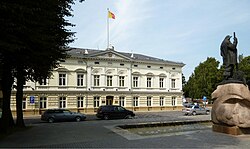Parliament of the Klaipėda Region

The Parliament of the Klaipėda Region (Chamber of Representatives of the Memel Territory, Lithuanian: Seimelis) was the parliament of the Klaipėda Region (Memel Territory), an autonomous region of Lithuania. The parliament was established by the Klaipėda Convention of 1924 and the first elections took place in October 1925.
History
[edit]According to the Treaty of Versailles of 1919, the Klaipėda Region (Memel Territory) was detached from East Prussia, German Empire, and placed under temporary administration of the League of Nations. After the Klaipėda Revolt in January 1923, the region was transferred to Lithuania on condition that it would abide by the Klaipėda Convention, signed in May 1924 and fully effective in August 1925.[1] The Convention included the Statute of the Klaipėda Region, which described region's legislative, judicial, administrative, and financial autonomy. The Convention also established the framework of the autonomous institutions – the local parliament and the Klaipėda Directorate (executive branch). The parliament was to be democratically elected for three-year terms by the local inhabitants in the proportion of one representative per 5,000 residents.[2] The parliament confirmed and dismissed the Directorate, appointed by the Governor. The Directorate and the Lithuanian-appointed Governor could dismiss the parliament; in such a case, the new elections had to be called within six weeks. The Governor could veto laws passed by the parliament, but only if they violated the Convention, Constitution of Lithuania, or other international agreements.[2] Of the 165 laws passed between 1925 and 1938, 62 were vetoed.[3] The parliament was in charge of region's education, religious affairs, public health and welfare, local infrastructure, civil, criminal, and economic legislature, finances, court organization, etc.[4]
In all elections 29 representatives were elected, and pro-German parties won a clear supermajority. The pro-German parliament often clashed with the more pro-Lithuanian Directorate. The first three parliaments were dismissed by the Directorate and the Governor.[3] In the 1932 case, the Permanent Court of International Justice ruled that the Lithuanians erred in dismissing the third parliament. After the crisis surrounding the trial of the Nazi activists, the 1935 election was postponed by the Lithuanians beyond the six-week period allowed by the Convention in hopes to build a pro-Lithuanian momentum.[5] The election law was also changed – the voters now had to submit 29 separate ballots for each individual they preferred, rather than a single ballot for a party. The German parties submitted a single unified list, while Lithuanian parties presented six.[5] The parliament was disbanded after the ultimatum of March 1939 and subsequent Nazi German takeover of the region.
Speakers of the Parliament
[edit]| Name | Period | Party |
|---|---|---|
| Joseph Kraus | 1925–1927 | Memel People's Party |
| Konrad von Dressler | 1927–1935 | Memel Agricultural Party |
| August Baldszus | 1935 | Unified German list |
| Christoph Dietschmons | (1936–1938)[6] [7] | Unified German list |
Election results
[edit]| Election date | Total | Lithuanian Parties | Memel Agricultural Party | Memel People's Party | Social Democratic Party of the Memel Territory |
Memel Workers Party | Other | |||||||||||||
|---|---|---|---|---|---|---|---|---|---|---|---|---|---|---|---|---|---|---|---|---|
| Votes | Turnout | Votes | % | Seats | Votes | % | Seats | Votes | % | Seats | Votes | % | Seats | Votes | % | Seats | Votes | % | Seats | |
| 1925-10-19 | 62,517 | 83.5% | 3,761 | 6.0% | 2 | 23,824 | 38.1% | 11 | 23,082 | 36.9% | 11 | 10,010 | 16.0% | 5 | 1,564 | 2.5% | – | 276 | 0.4% | – |
| 1927-08-30 | 54,746 | 7,311 | 13.4% | 4 | 18,776 | 34.3% | 10 | 17,636 | 32.2% | 10 | 5,712 | 10.4% | 3 | 3,844 | 7.0% | 2 | 1,467 | 2.7% | – | |
| 1930-10-10 | 49,630 | 8,817 | 17.8% | 5 | 15,810 | 31.8% | 10 | 13,709 | 27.6% | 8 | 6,780 | 13.7% | 4 | 2,062 | 4.2% | 2 | 2,452 | 4.9% | – | |
| 1932-05-04 | 65,767 | 11,968 | 18.2% | 5 | 24,468 | 37.2% | 11 | 17,930 | 27.3% | 8 | 5,104 | 7.7% | 2 | 5,401 | 8.2% | 3 | 896 | 1.4% | – | |
| Lithuanian lists | Unified German list[nb 1] | Part of the German list | None | |||||||||||||||||
| 1935-09-29 | 1,962,061 | 91.3% | 369,457 | 18.3% | 5 | 1,592,604 | 81.7% | 24 | ||||||||||||
| 1938-12-11 | 2,095,206 | 96% | 268,585 | 12.8% | 4 | 1,826,621 | 87.2% | 25 | ||||||||||||
Main source: Žostautaitė, Petronėlė (1992). Klaipėdos kraštas: 1923-1939 (in Lithuanian). Mokslas. pp. 70–71. ISBN 978-5-420-00724-2.
Notes
[edit]- ^ Memelländische Einheitsliste in 1935, Memeldeutsche Einheitsliste in 1938
References
[edit]- ^ Gliožaitis, Algirdas Antanas (2003). "Klaipėdos krašto konvencija". Mažosios Lietuvos enciklopedija (in Lithuanian). Vol. 2. Vilnius: Mokslo ir enciklopedijų leidybos institutas. p. 189. ISBN 5-420-01470-X.
- ^ a b League of Nations Treaty Series (1924). Convention concerning the Territory of Memel (PDF). Vol. 29. pp. 99–101.
- ^ a b Žostautaitė, Petronėlė (1985–1988). "Seimelis". In Zinkus, Jonas; et al. (eds.). Tarybų Lietuvos enciklopedija (in Lithuanian). Vol. 3. Vilnius: Vyriausioji enciklopedijų redakcija. p. 644. LCCN 86232954.
- ^ a b Gliožaitis, Algirdas Antanas (2003). "Klaipėdos krašto seimelis". Mažosios Lietuvos enciklopedija (in Lithuanian). Vol. 2. Vilnius: Mokslo ir enciklopedijų leidybos institutas. p. 191. ISBN 5-420-01470-X.
- ^ a b Himmel, Richard Lynn (August 1975). Years of crisis diplomacy: German-Lithuanian relations, 1933-1939 (PDF). Texas Tech University. pp. 34–35. OCLC 1966819. Archived from the original (PDF) on 15 August 2011. Retrieved 3 February 2011.
- ^ Memeler Dampfboot from 29.01.1936 Page 2
- ^ Memeler Dampfboot from 27.01.1937 Page 5
